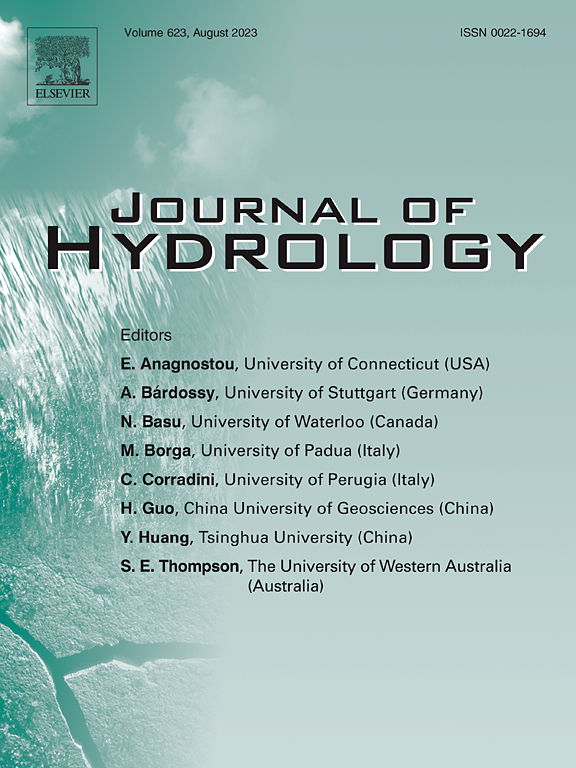Tracking persistent declines in suspended sediment in the Lower Mississippi and Atchafalaya Rivers, 1992–2021: Harnessing WRTDSplus to characterize longitudinally varying trends and explore connections to streamflow
IF 6.3
1区 地球科学
Q1 ENGINEERING, CIVIL
引用次数: 0
Abstract
Suspended sediment (SS) continues a century-long decline in the Lower Mississippi and Atchafalaya Rivers, United States. In this study, we use the WRTDSplus model to estimate concentrations and loads for total, fine (<0.0625 millimeter (mm)), and coarse (≥0.0625 mm) SS for 11 sites. This extension of the Weighted Regressions on Time, Discharge, and Season (WRTDS) model allows a fourth explanatory variable in the model formulation. We incorporated hysteresis terms for most models based on a residual analysis, which allowed for the identification of decreased flushing over time at some sites. Total, fine, and coarse SS concentrations and loads decreased at all sites over two trend periods (water years (WY) 1992–2021 and WY 2012–2021). Declines were largely due to changes in fine SS (mud and silt) but decreases in coarse SS (sands) were also widespread. On average, recent declines are more severe in the Lower Mississippi River below the Old River Control Complex (ORCC, −3.7 mg per liter per year (mg/L/yr)) compared to the Atchafalaya River (−2.0 mg/L/yr), although there is longitudinal variability within each river. The reach below the ORCC is a net SS sink, leading to complex temporal changes for the sites in this area. Streamflows (low, moderate, and high) have increased over these periods, with the last decade being particularly wet. Increasing streamflow and decreasing SS, with little evidence of amelioration, may influence spillway operations during floods, sediment diversion construction and operation, coastal restoration efforts, and aquatic health.
追踪1992-2021年密西西比河下游和阿查法拉亚河悬浮沉积物的持续下降:利用WRTDSplus来表征纵向变化趋势并探索与河流流量的联系
悬浮沉积物(SS)在美国密西西比河下游和阿查法拉亚河持续了一个世纪的下降。在这项研究中,我们使用WRTDSplus模型估计了11个站点的总SS、细SS (<0.0625 mm)和粗SS(≥0.0625 mm)的浓度和负荷。对时间、流量和季节加权回归(WRTDS)模型的扩展允许在模型公式中加入第四个解释变量。我们在残差分析的基础上为大多数模型加入了滞后项,这允许在某些地点识别随时间推移而减少的冲洗。在两个趋势期(水年)(1992-2021年和2012-2021年),所有站点的总、细、粗SS浓度和负荷均有所下降。减少主要是由于细SS(泥浆和淤泥)的变化,但粗SS(砂)的减少也很普遍。平均而言,与阿查法拉亚河(−2.0 mg/L/yr)相比,在旧河控制综合体(ORCC,−3.7 mg /L/yr)以下的密西西比河下游,最近的下降更为严重,尽管每条河流内部存在纵向变化。ORCC以下的河段是净SS汇,导致该地区站点的复杂时间变化。在这些时期,河流流量(低、中、高)都有所增加,最近十年尤其潮湿。在几乎没有改善迹象的情况下,增加流量和减少SS可能会影响洪水期间的溢洪道运营、泥沙分流建设和运营、海岸恢复工作和水生健康。
本文章由计算机程序翻译,如有差异,请以英文原文为准。
求助全文
约1分钟内获得全文
求助全文
来源期刊

Journal of Hydrology
地学-地球科学综合
CiteScore
11.00
自引率
12.50%
发文量
1309
审稿时长
7.5 months
期刊介绍:
The Journal of Hydrology publishes original research papers and comprehensive reviews in all the subfields of the hydrological sciences including water based management and policy issues that impact on economics and society. These comprise, but are not limited to the physical, chemical, biogeochemical, stochastic and systems aspects of surface and groundwater hydrology, hydrometeorology and hydrogeology. Relevant topics incorporating the insights and methodologies of disciplines such as climatology, water resource systems, hydraulics, agrohydrology, geomorphology, soil science, instrumentation and remote sensing, civil and environmental engineering are included. Social science perspectives on hydrological problems such as resource and ecological economics, environmental sociology, psychology and behavioural science, management and policy analysis are also invited. Multi-and interdisciplinary analyses of hydrological problems are within scope. The science published in the Journal of Hydrology is relevant to catchment scales rather than exclusively to a local scale or site.
 求助内容:
求助内容: 应助结果提醒方式:
应助结果提醒方式:


